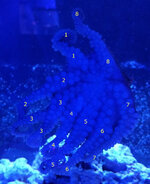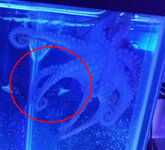Hi everyone. New member to the forum, not new to keeping saltwater creatures. I've kept saltwater tanks since 2007. I started working at the National Aquarium in Baltimore a few years ago and fell in love with our GPO Lola (who has sadly passed away recently). Ever since I first interacted with her, I've been determined to keep an octopus of my own. KP Aquatics recently got a few octopuses in stock, so I picked one up. I have no clue what he is though. All I can say is he's from the Caribbean.
He was sold as an "octopus", not a "dwarf octopus." From previous posts, it seemed that the "octopus" KP Aquatics usually sold was a O. Briareus, but this guy doesn't appear to be O. Briareus. He doesn't look as small as some pictures I've seen of O. Joubini, but he's still pretty small. His mantle is probably 2 inches long at the most. I've looked at countless pictures and haven't been able to identify him yet. The most distinct feature he appears to have is a ring underneath his eye on each side that's only visible sometimes. I've attached a few pictures of him at the end of the post. I'd be very appreciative if anyone could offer some insight into what specie he is.
He's in a dedicated 40g breeder and is doing great so far. He took very readily to frozen shrimp, which was a big relief. One of these days I'm going to order some grass shrimp and see if he'll go for those.
At any rate, happy to be here! Thanks for letting me share


He was sold as an "octopus", not a "dwarf octopus." From previous posts, it seemed that the "octopus" KP Aquatics usually sold was a O. Briareus, but this guy doesn't appear to be O. Briareus. He doesn't look as small as some pictures I've seen of O. Joubini, but he's still pretty small. His mantle is probably 2 inches long at the most. I've looked at countless pictures and haven't been able to identify him yet. The most distinct feature he appears to have is a ring underneath his eye on each side that's only visible sometimes. I've attached a few pictures of him at the end of the post. I'd be very appreciative if anyone could offer some insight into what specie he is.
He's in a dedicated 40g breeder and is doing great so far. He took very readily to frozen shrimp, which was a big relief. One of these days I'm going to order some grass shrimp and see if he'll go for those.
At any rate, happy to be here! Thanks for letting me share



 ). It is almost as if they slowly make ink and have to reduce the volume (probably the wrong guess but there is something different about them). For all but one of the hummelinckis I have, the inking occurs in small releases and often for no apparent reason and without disaster. The one instance where this was not the case the animal completely blackend the tank and the water bucket I removed her to while she was discharging the ink. Once she stopped and I put her in another aquarium (fortunately I had an appropriate tank available) there was never another problem. I had to do a complete water change on the 60 she polluted. I have no clue why it happened. There is a similar incidence with a vulgaris but sadly there was not a spare, unpolluted tank available and the animal died (which may or may not have been a result of the inability to rehouse it).
). It is almost as if they slowly make ink and have to reduce the volume (probably the wrong guess but there is something different about them). For all but one of the hummelinckis I have, the inking occurs in small releases and often for no apparent reason and without disaster. The one instance where this was not the case the animal completely blackend the tank and the water bucket I removed her to while she was discharging the ink. Once she stopped and I put her in another aquarium (fortunately I had an appropriate tank available) there was never another problem. I had to do a complete water change on the 60 she polluted. I have no clue why it happened. There is a similar incidence with a vulgaris but sadly there was not a spare, unpolluted tank available and the animal died (which may or may not have been a result of the inability to rehouse it).